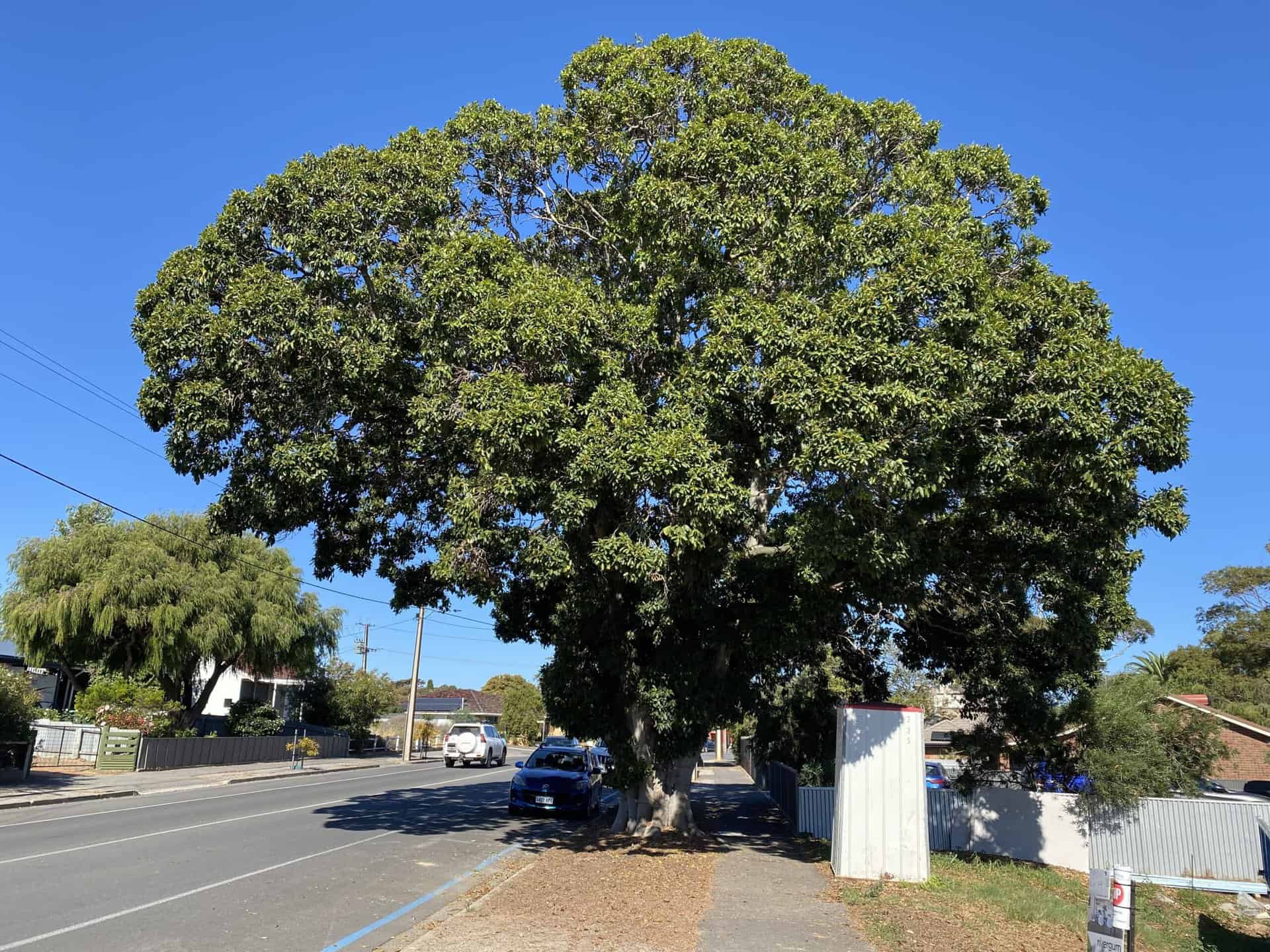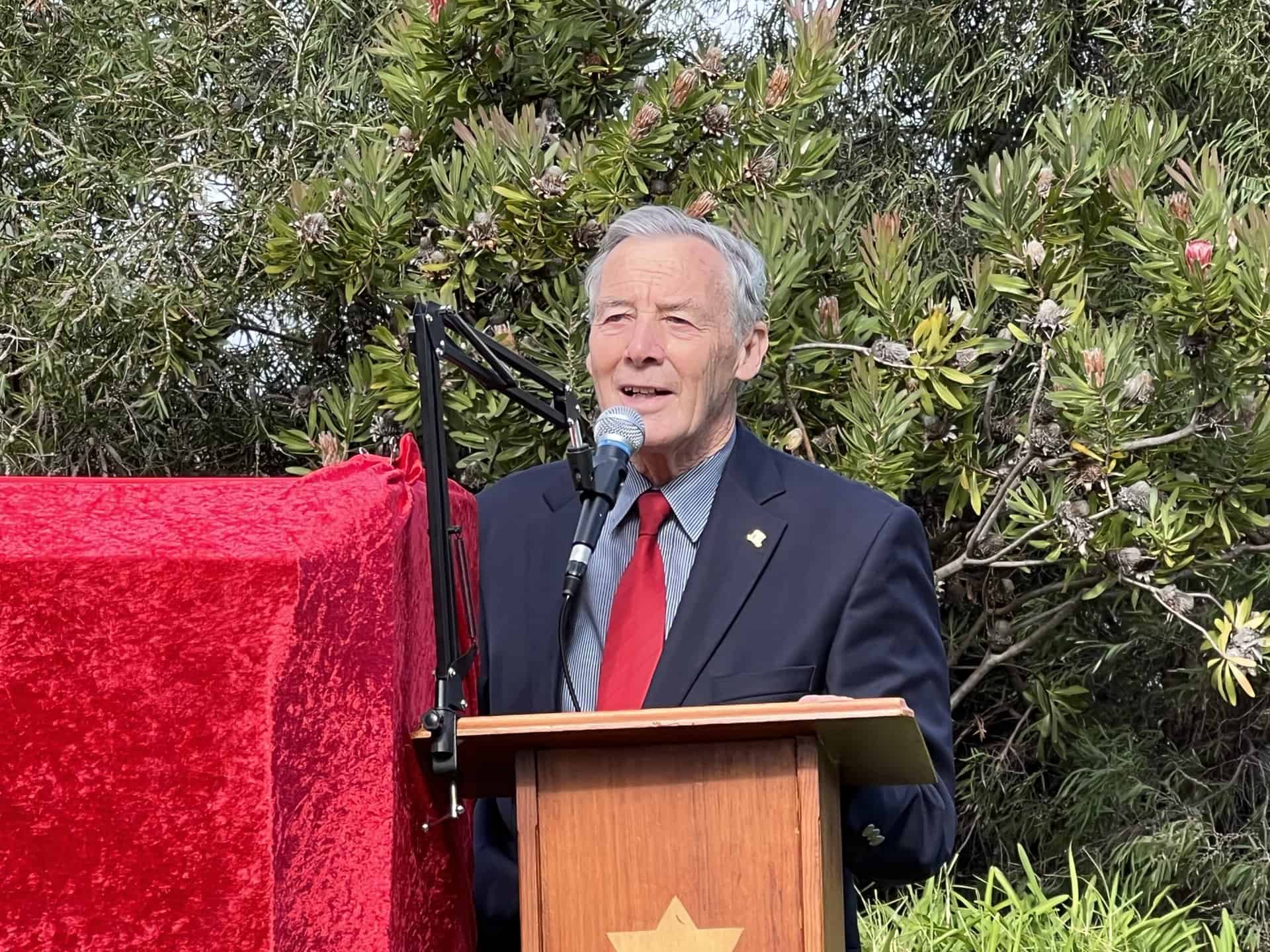This is one of the original 19 Moreton Bay Figs planted by Mr. R.B. Clark in honour of each local volunteer from the area who fought in World War I.
It’s one of two located on the corner of Main Road and Jetty Road, Normanville.

In his PhD Thesis “First World War Avenues of Honour: Social History through the Landscape“, 2018, Federation University, Dr Michael Taffe, author and historian, reveals the Normanville trees formed the first WW1 war memorial avenue in Australia. The trees used were Moreton Bay Figs (Ficus macrophylla) that had been provided by and planted by Mr R. B. Clark and were ‘intended to serve as a living monument to his [each volunteer] gallantry’. Each tree had the soldier’s name and details attached.” pp 130-131
“Clark’s Living Roll of Honour” is declared the very first such WW1 memorial avenue planted in Australia – before the concept of the Anzac Memorial was recognised. It is also Australia’s first privately funded and donated living memorial to the service and sacrifice of soldiers during the Great W ar.

THE COUNTRY.
A TREE FOR EACH VOLUNTEER
NORMANVILLE, June 21, 1915.
Recently Mr. R.B. Clark conceived a novel scheme for perpetuating the memory of many courageous young men who have gone from this neighbourhood to help in the defeat of the Empire’s enemies.
A couple of years ago, a scheme for beautifying the township of Normanville was created by tree planting along the streets. This was embarked upon by a committee of residents, but the majority of the trees, in consequence of the extraordinary dry weather, did not thrive.
The present season appears to be much more propitious, and Mr. Clarke has decided to plant, at his own expense, a Moreton Bay fig tree in honour of each volunteer.
To each, a tree guard will be attached a card giving the name of the volunteer in whose honour the tree is planted, and bearing the words. “When can his glory fade” and an appeal for the protection of the tree. The row has been designated “Clark’s Living Roll of Honour”.
Already one tree is singled out `for special and reverent care, the young soldier whose name it bears having sacrificed his life for his country at the Dardanelles on May30, 1915, that being of A.S. McArthur, killed in action.
Those honoured to date are: Maj J.W. Parsons; Sgt. A Clarke, Lce Cpls. S.G. Dixon and W.R. Caper, Ptes, A. Clarke, W.R. Dixon, A. Scott, W. Dunstall, A.S. McArthur (killed), L. Tonkin, B. Martin, F. Forrest, F. Pengilley, C. Smith, W. Smith, A. Smith, S. Martin, J. Sinclair (wounded), H. Caudle, J. Hoskins, F. Clarke (from Sydney), A. Skinner (H.M.A.S Australia) and Driver H. Collins (wounded).
– The Register (Adelaide SA 1901-1929),
Tuesday, June 22nd, 1915, p.10.

These next images show the only 8 remaining survivors out of that original 19, sparsely scattered along the Main Road through the township of Normanville.
 |  |
 |  |
 |  |
 |  |
These vestiges of honour are lost in the clutter and movement of the town.
Up until relatively recently, they’ve been little regarded and not readily apparent as to their true history and heritage value to the nation.
Local community representatives from the Yankalilla Lions Club, Yankalilla and District Historical Society and The District Council of Yankalilla were keen to generate a more public focus on the story of Clark’s Living memorial. By invitation, during mid-late 2021, support and encouragement was provided by avenues historian Dr Michael Taffe, TREENET, the Avenues of Honour project and significant tree history enthusiasts.

Research, advocacy, and a series of meetings, led by the local community from Normanville and Yankalilla district, resulted in celebratory events in May 2022. The first of these was a presentation by Dr Michael Taffe, entitled “Keeping the Faith, the Great War Avenues of Honour”, on Friday 13th May.
This was on the 107th anniversary of the first Moreton Bay Fig tree planting in 1915.
 |  |
 |  |
Top-left: Dr Michael Taffe
Top-right: Cr Glen Rowlands, District Council of Yankalilla
Bottom-left: Rebecca Sharkie, Federal Member for Mayo
Bottom-right: Large interpretive sign “Living Avenue of Honour – A Living Monument to their Gallantry”.
Images: Glenn Williams
This aerial map illustrates the location of the surviving living memorials – and hints at potential open spaces where new Figs might be planted to reinstate the missing 11.



